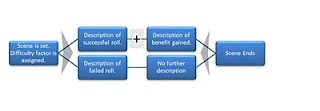Game Mechanism of the Week 2011: 1 – A typical percentile skill system
I’m going to start this analysis with one of the old chestnuts of roleplaying, the percentile skill system. This is found in earlier versions of D&D, as well as the range of Palladium roleplaying games, Call of Cthulhu, and plenty of the Old-School Renaissance games. It’s a simple game mechanism following three basic steps.
1. You have a target number; the target number is typically based on your character’s skill level plus or minus a difficulty factor. The reason for the difficulty factor is typically described in the fiction.
2. You roll a percentile die and compare it to the target number.
3. One of two results occurs
a. You beat the target number and you either gain an advantage or avoid a penalty.
b. You fail to beat the target number and you either suffer a penalty or don’t gain the advantage.
This mechanism can be applied in a few ways in a game.
In many “railroaded” linear games, the percentile roll is simply used to determine whether advantages are gained while on the inevitable path to the confrontation at the end of the story.
Some percentile rolls have a chance of providing bonuses.

Other percentile rolls have a chance of inflicting penalties.

Some novice GMs think it’s clever to create scenes where there is a chance of both bonuses or penalties. There is nothing overly revolutionary about this and when analysed, it follows the same basic event structure.

When moving to “non-railroaded” storylines, the simple percentile roll still only offers two possible outcomes. Either you are successful and you follow one story path, or you are unsuccessful and you follow another story path. Depending on the specific scene, one character might make the roll for the entire group, or multiple players might get the opportunity to try their luck.

At a more complex level, some systems may allow players to introduce advantages to maximise their chances of success (such advantages might be equipment that provides a +X% bonus, or special benefits that decrease a difficulty number in certain situations). Some systems do the same with penalties (perhaps injuries cause a general negative to all skill rolls). In a computer roleplaying game, these advantages and disadvantages are often calculated automatically before randomised outcomes are generated; in a table-top game players and GM need to remember which effects modify the target number at which times. On the whole though, a percentile system such as this doesn’t offer a lot of player agency. Instead, it’s binary; either you do it (you follow one set of results), or you don’t (you follow the other set of results). Any chances of maximising a character’s potential are resolved before the scene begins (during the character generation phase), the rest is basically a crap shoot. To properly protagonise the characters, you need to incorporate other game mechanisms….but then again, some players don’t like being forced to make decisions for themselves, they just like to build their characters then sit back and enjoy the ride.

.png)

Comments
"
1. You have a target number; the target number is typically based on your character’s skill level plus or minus a difficulty factor. The reason for the difficulty factor is typically described in the fiction.
2. You roll a percentile die and compare it to the target number.
3. One of two results occurs
"
I don't see the Y, Y, or O. Interesting. I didn't know there were numbered bullet points... I copy-pasted into this comment box and got the missing "1. Y", "2. Y", and "3. O".
Thanks, I'll fix that up.